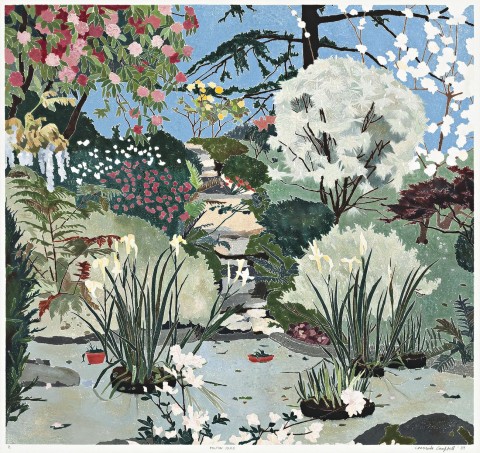MILTON PARK, 1989
CRESSIDA CAMPBELL
unique colour woodblock print
71.0 x 75.5 cm
signed, dated and inscribed with title below image
Rex Irwin Art Dealer, Sydney
Anne Schofield, Sydney
Sotheby's Australia, Sydney, 28 April 2015, lot 64
Private collection, Sydney
Cressida Campbell Wood Block Prints, Rex Irwin Art Dealer, Sydney, 17 October – 4 November 1989, cat. 10 (label attached verso)
Timeless: The Art of Cressida Campbell, S.H. Ervin Gallery, Sydney, 10 January – 22 February 2009 and touring to Queensland University of Technology, Art Museum, Brisbane, cat. 47
Crayford, P. (ed.), The Woodblock Painting of Cressida Campbell, Public Pictures, Sydney, 2008, cat. P8910, pp. 315 (illus.) 342
By 1989, Cressida Campbell, not yet thirty years old, had already won two major prizes for her idiosyncratic woodcuts and monoprints. Reaching far beyond an appreciation of her mature handling of a difficult medium, the enduring attraction of Campbell’s work instead lies in its subject matter: an exaltation of the simple and calm beauty of life. She devotes the same degree of attention to all her subjects, intimate still lives and spectacular panoramas alike. This unique print, Milton Park, 1989, is one of the latter, displaying a dense and harmonious pattern of botanic luxuriance.
Milton Park, located in Bowral in New South Wales’ Southern Highlands, is a grand country estate from the early twentieth century, transformed in the 1980s into a luxury hotel and its vast gardens opened to the public. Established by Anthony Hordern, wealthy grazier and retailing heir, and his second wife Mary Bullmore, Milton Park is considered one of Australia’s greatest private gardens, housing a wide range of rare European trees and botanical specimens. With a temperate climate, removed from the humidity and heat of the East coast, the Highlands have long since provided a bucolic sanctuary for pastoral homes, boasting a genteel refinement and cultivation of the land.
In Milton Park, Campbell’s view of a tranquil pond bordered by grassy knolls and flowering fruit trees is tightly cropped, and with its slightly asymmetric balance is a good example of Campbell’s Japanese aesthetic. The powdery and mottled surface created by her printing process from watercolour pigments is well suited to the range of textures found in this garden. Gently incising the contrasting outlined forms of different botanical specimens, from the elegant reflected stems of floating yellow irises in the foreground, to the spare branches of an ancient Fir tree beyond the horizon, Campbell demonstrates a sophisticated handling of composition and design.
In contrast to her industrial harbourside images, floral still lives and panoramas of the spiky Australian bush, Milton Park is a view of a distinctly European garden. The print nevertheless shares the same a clear connection to and understanding of place found in the rest of Campbell’s oeuvre. This landscape is transformed, its flora introduced from far-flung climates and tamed into herbaceous borders and stepped flower beds. The grounds of Milton Park burst forth in Campbell’s print with springtime exuberance. Quietly optimistic and unpretentiously displaying a delight for simple sensory pleasures, Milton Park is reminiscent of Stanley Spencer’s English garden paintings, so admired by Campbell. A serene richness is created by evoking other sensory experiences, particularly floral fragrances and sonorous qualities of rippling pools and wind in leaves.
LUCIE REEVES-SMITH
